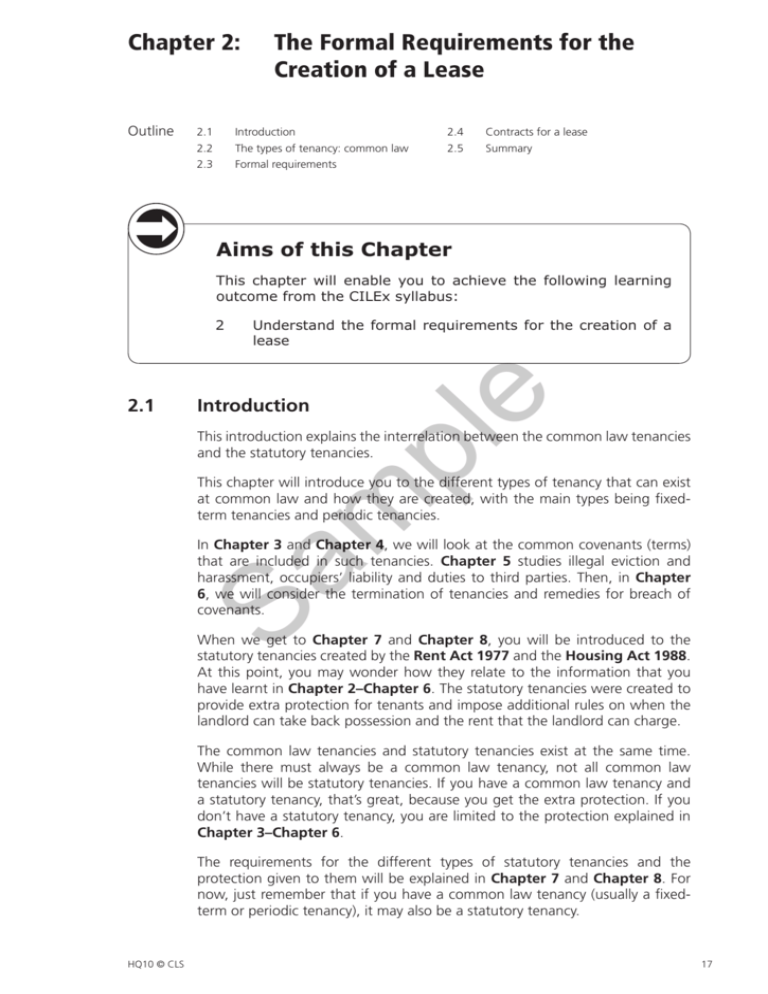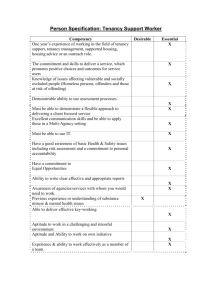
Chapter 2:
Outline
The Formal Requirements for the
Creation of a Lease
2.1
Introduction
2.4
Contracts for a lease
2.2
The types of tenancy: common law
2.5
Summary
2.3
Formal requirements
Aims of this Chapter
This chapter will enable you to achieve the following learning
outcome from the CILEx syllabus:
2.1
Understand the formal requirements for the creation of a
lease
Introduction
e
2
pl
This introduction explains the interrelation between the common law tenancies
and the statutory tenancies.
Sa
m
This chapter will introduce you to the different types of tenancy that can exist
at common law and how they are created, with the main types being fixedterm tenancies and periodic tenancies.
In Chapter 3 and Chapter 4, we will look at the common covenants (terms)
that are included in such tenancies. Chapter 5 studies illegal eviction and
harassment, occupiers’ liability and duties to third parties. Then, in Chapter
6, we will consider the termination of tenancies and remedies for breach of
covenants.
When we get to Chapter 7 and Chapter 8, you will be introduced to the
statutory tenancies created by the Rent Act 1977 and the Housing Act 1988.
At this point, you may wonder how they relate to the information that you
have learnt in Chapter 2–Chapter 6. The statutory tenancies were created to
provide extra protection for tenants and impose additional rules on when the
landlord can take back possession and the rent that the landlord can charge.
The common law tenancies and statutory tenancies exist at the same time.
While there must always be a common law tenancy, not all common law
tenancies will be statutory tenancies. If you have a common law tenancy and
a statutory tenancy, that’s great, because you get the extra protection. If you
don’t have a statutory tenancy, you are limited to the protection explained in
Chapter 3–Chapter 6.
The requirements for the different types of statutory tenancies and the
protection given to them will be explained in Chapter 7 and Chapter 8. For
now, just remember that if you have a common law tenancy (usually a fixedterm or periodic tenancy), it may also be a statutory tenancy.
HQ10 © CLS
17
The Formal Requirements for the Creation of a Lease
2.2
The types of tenancy: common law
2.2.1
Fixed-term tenancy
One of the two most common forms of tenancy is a fixed-term tenancy.
A fixed-term tenancy can be of any duration and comes to an end automatically
on the expiration of the fixed term. No notice to quit is required to bring the
tenancy to an end. The tenancy may be terminated early, for instance, by
forfeiture or by operation of a break clause, inserted into the lease.
2.2.2
Periodic tenancy
e
This is the other common type of tenancy. The total duration of a periodic
tenancy is not fixed from the outset. It continues automatically from period
to period until it is terminated by notice at the end of one period. The period
may be of any duration, for example, weekly, monthly, quarterly or yearly. A
yearly periodic tenancy only needs six months’ notice. A periodic tenancy of a
dwelling requires a minimum of four weeks (see 6.3.2).
Sa
m
pl
Periodic tenancies are regarded as being of fixed maximum duration provided
that either side knows what notice he needs to give to terminate: see Prudential
Assurance Co Ltd v London Residuary Body [1992] at 1.3.2.2. Periodic
tenancies can arise either expressly or by implication.
(1) Express periodic tenancies: this is the most obvious method of creation
of a periodic tenancy and may arise by the use of such words as “to X from year
to year” or “to Y as a yearly tenant”.
(2) Implied periodic tenancies: a periodic tenancy may be implied on the
basis of calculation of rent or on the basis of the intervals between payments
of rent, for instance, “to X at £1,200 per year” or “to Y at £100 payable
monthly”.
An express periodic tenancy, like any express term, overrides a periodic tenancy
implied on the basis of calculation of rent. An implied tenancy based on
calculation of rent overrides an implication based on the intervals between
payments: for example, “A lease from month to month at £1,200 per annum”
creates an express monthly tenancy, while “A lease at £1,200 per year payable
monthly” creates an implied yearly periodic tenancy based on calculation of
rent.
2.2.3
Tenancy at will
A tenancy at will arises when a tenant occupies land with the consent of the
owner on the basis that either party can bring the tenancy to an end at any
time. It can be created either expressly or by implication.
18
HQ10 © CLS
The Formal Requirements for the Creation of a Lease
(1)
Express tenancy at will
An illustration is Manfield v Botchin [1970], where the landlord created an
express tenancy at will of business premises, so as to be sure of being able
to regain possession immediately on being granted planning permission for
redevelopment. Express creation, although rare, may thus be useful in order
to avoid the creation of a periodic tenancy and the consequent need to give a
long period of notice to terminate.
(2)
Implied tenancy at will
An implied tenancy at will arises when a tenant holds over (remains in
possession), with the consent of the landlord, after termination of an existing
tenancy.
e
In Wheeler v Mercer [1957], for instance, the landlord had given valid
notice to quit the leased land. This notice had expired. The tenant nevertheless
remained in possession whilst negotiations for a new lease were under way.
These negotiations broke down. The House of Lords held that there was a
tenancy at will, which could be terminated at any time by the landlord.
pl
In fact, a tenancy at will is very rare in this circumstance, as some form of
statutory tenancy usually comes into existence on the tenant holding over, for
instance, under RA 1977.
Sa
m
Much more common and much more important is where a tenancy at will
arises when a tenant enters into possession under an informal legal lease: for
example, for lack of a deed (see 2.3.1).
When an implied tenant at will pays, or agrees to pay, rent, a periodic tenancy
will be implied as above, based on the method of calculation, or failing this, the
intervals between payments of rent.
In Javad v Aqil [1991], an express tenant at will paid rent monthly pending
negotiations for the full grant of a lease. Negotiations broke down and the
defendant tried to claim that he had a periodic tenancy. The Court of Appeal
disagreed due to lack of intention and confirmed that the defendant had a
tenancy at will.
In Arben Katana (1) and Dan Abraham (2) v Catalyst Communities
Housing Limited [2010], the Court of Appeal affirmed the principle that the
law presumes the creation of a tenancy at will following the expiry of a fixedterm tenancy and declined to displace this presumption on the evidence of an
alternative arrangement between the parties.
The housing association had acquired an old garage, on which it intended to
build social housing. It expected the process of getting planning permission to
be arduous. It therefore let out the site to a third party, who in turn let it out
to the two appellants on long leases. The third party subsequently vanished.
Four years later, during which time the tenants paid rent monthly, the housing
association tried to get possession from the appellants. They resisted saying
that they were periodic tenants and, as they carried out their businesses from
the site, had protection under the Landlord and Tenant Act 1954 (LTA 1954).
HQ10 © CLS
19
The Formal Requirements for the Creation of a Lease
The housing association maintained, however, that they were merely tenants
at will and pointed to a clause in the original agreement which said that the
agreement was for a fixed term of three months and thereafter terminable on
not less than a week’s notice.
Despite the length of time the appellants had occupied the site – some four
years, paying rent monthly – with the housing association’s knowledge, the
Court of Appeal said that a periodic tenancy did not exist. It was a tenancy
at will. If this had been a residential tenancy, this result would have been very
surprising; however, in commercial situations, the court is always slower to look
behind the terms of the written agreement.
2.2.4
Sa
m
pl
e
The Court of Appeal has confirmed a similar approach in Barclays Wealth
Trustees (Jersey) Ltd v Erimus Housing Ltd [2014] where a tenant was
holding over after the expiry of a commercial lease that did not have security
of tenure under LTA 1954. There were ongoing negotiations for a renewal
lease during the holding over period but the tenant eventually gave notice to
quit. The question was whether a periodic tenancy arose (which would gain
protection) or it was merely a tenancy at will (as the landlord consented to the
arrangement). It was found that an intermediate contractual relationship was
not intended because of the ongoing negotiations, a periodic tenancy would
gain statutory protection but the negotiations were for a lease contracted out
of the security of tenure provisions. The outcome had to be consistent with the
intentions of the parties: a tenancy at will was found and so the tenant’s notice
to quit was valid.
Tenancy at sufferance
A tenancy at sufferance arises where a tenant occupies land without his
landlord’s consent or despite objection by holding over after the expiration
of a lease. It is essential that the initial entry was lawful and with consent; on
expiration of this initial right to occupy, there can be no agreement as to the
tenancy, as the essence of a tenancy at sufferance is that the landlord does not
agree to its existence.
Where there is a tenancy at sufferance, the landlord can recover possession
and terminate the tenancy at any time. The tenant has rights in the land and
can bring an action in trespass or ejectment against third parties. Subsequent
events may result in the following occurring.
(1) If the landlord requires the tenant to quit, the tenant becomes a trespasser
(the tenant may, as with a tenancy at will, have a statutory right to remain in
possession).
(2) If the landlord signifies his consent, the tenant becomes a tenant at will
and if the tenant then pays, or agrees to pay, rent, an implied periodic tenancy
is created based on calculation of rent or intervals of payment.
(3) If a tenant at sufferance retains possession for the appropriate period
without payment of rent, he may acquire title by adverse possession.
20
HQ10 © CLS
© 2015 Copyright CILEx Law School Limited
All materials included in this CLS publication are copyright protected.
All rights reserved.
Any unauthorised reproduction or transmission of any part of this
publication, whether electronically or otherwise, will constitute an
infringement of copyright. No part of this publication may be lent, resold
or hired out for any purpose without the prior written permission of
CILEx Law School Ltd.
e
WARNING: Any person carrying out an unauthorised act in relation
to this copyright work may be liable to both criminal prosecution
and a civil claim for damages.
pl
This publication is intended only for the purpose of private study. Its
contents were believed to be correct at the time of publication or any
date stated in any preface, whichever is the earlier.
Sa
m
This publication does not constitute any form of legal advice to any person
or organisation.
CILEx Law School Ltd will not be liable for any loss or damage of any
description caused by the reliance of any person on any part of the
contents of this publication.
Published in 2015 by:
CILEx Law School Ltd
College House
Manor Drive
Kempston
Bedford
United Kingdom
MK42 7AB
British Library Cataloguing in Publication Data
A catalogue record for this manual is available from the British Library.
ISBN 978-1-84256-839-2




